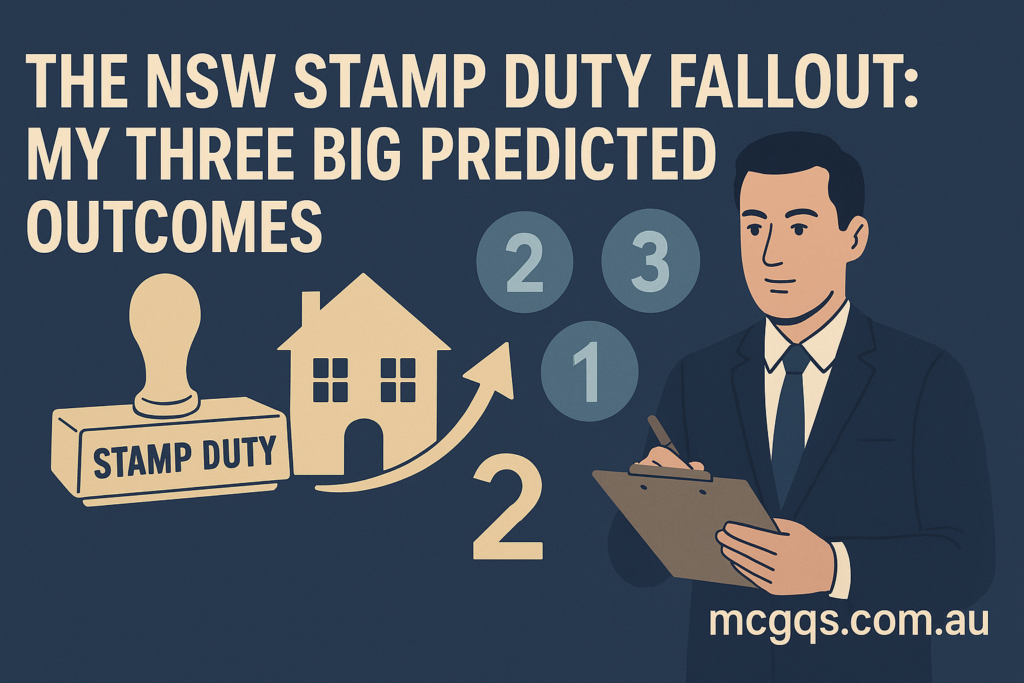The NSW Stamp Duty fallout: my three big predicted outcomes

There’s been a cacophony of opinion this week filling column inches and taking over the airwaves of property centric media.
Refreshingly, the big news wasn’t pandemic related. Nor did it involve a concession speech of any description.
No, the chatter has been dominated by a NSW government discussion around the abolition of stamp duty which is a thorn in the side of property owners.
Given there was an expectation stamp duty would be substantially curtailed – if not abolished all together – in the wake of the GST’s implemented in 2000, this new proposal has been a long time coming.
There appears to be much dancing and rejoicing about the plan – well, awkward dad-dancing and restrained accountant-style rejoicing anyway – but as is often the case, we have precious little fine detail on the proposal at present. As such, trying to predict the exact fallout of this change is difficult.
But I’ve never been one to shy away from a challenge – particularly when it comes to tax matters. It’s my extraordinarily boring superpower.
Here’s a summary of the proposal and my three long-range predicted outcomes should the changes come to pass.
The proposal
The NSW proposal would essentially see buyers given the choice of paying stamp duty or opting for an annual land tax when acquiring a property.
This would mean purchasers could choose an ongoing yearly land tax payment rather than a lump sum stamp duty which, by the way, is just over $42,000 based on the median Sydney house price at present.
According to media reports, because there’s been far less market activity this year (due to some global pandemic or something) the revenue generated from stamp duty has fallen dramatically. As such, now is a prime time to implement the changes. Not only would a restructure be less painful right now, but government has grown more accustomed to lower stamp duty.
But it’s not all altruism on the state’s part. A 2019 Grattan Institute study on the abolition of stamp duty stated:
“…shifting from stamp duties to a broad-based property tax could leave NSW between $4.1 billion and $5.2 billion a year better off.”
In short, abolishing stamp duty should make it easier for many buyers to purchase a home, and the annual land tax means the government is receiving a more regular income stream.
Seems like a win for everyone at this stage
My three predictions
Let me say from the outset, details about the proposal are still a bit light on, but let’s assume the protocols will continue to be generally in line with the information we have to hand.
Prediction one. I suspect there will be increased buyer demand for property that’s been opted into land tax rather than stamp duty.
These assets will be more price accessible, especially for first homebuyers and investors. If buyers are choosing between a transaction with a big up-front cost, and one with more manageable ongoing cost, then the latter is going to come up trumps in most instances. The result of higher demand is (all things being equal) higher prices too, so expect to see land-tax properties fetch more than their stamp-duty contemporaries.
Prediction two. Be prepared for a potential two-tiered market divided along property value lines if they don’t change the way land tax is worked out at the moment.
Annual land tax is currently assessed on the basis a property owner’s holdings exceeding a threshold of $755,000 in taxable land value. While details are yet to emerge on what thresholds will be in place under a new system, if the status quo of land tax thresholds were maintained, those who sit below the figure are unlikely to adopt the ‘pay upfront stamp duty’ option.
I have one big caveat though. Governments have a history of finding ways to get their pound of flesh. I don’t really believe they’d introduce a scheme that provides a loophole for avoiding tax altogether, so expect a flat percentage or sliding scale of some description to ensure the money keeps flowing into consolidated revenue.
My third call is a bit more solid. I think 2022 could be ‘The year of the NSW flipper’ under the changes.
Buying a dodgy property, doing a quick fix up and on selling for a profit was extremely popular a decade or so ago. In the ensuing years – national economic challenges aside – it seemed every woman and her dog wanted to give flipping a go, so competition for renovatable property heated up.
But a big part of making a flipping profit is keeping costs down, and stamp duty has been a monstrous drag on the bottom line of renovation projects. The removal of stamp duty would help make flipping more profitable.
There are wider flow on benefits from this prediction as well. Beyond simply the property owner’s financial gain, there’s the broader economic upside with increased use of consultants, contractors and materials. Flipping is an excellent stimulus for the real estate sector, so let’s hope I’ve nailed that one like Nostradamus on a good day.
So, I say ‘hurrah!’ to the proposed changes but I look forward to seeing the nitty gritty instil more confidence into an industry that’s the economic foundation of this country.
Mike Mortlock is a Quantity Surveyor and Managing Director of MCG Quantity Surveyors. MCG Specialise in Tax Depreciation Schedules and Construction Cost Estimating. You can visit them at www.mcgqs.com.au Mike Mortlock is a Tax Depreciation expert, Quantity Surveyor and Managing Director of MCG Quantity Surveyors. He is a regular speaker and commentator having been featured in the Financial Review and Sky Business. MCG Specialise in Tax Depreciation Schedules and Construction Cost Estimating for investors. You can visit them at https://www.mcgqs.com.au
